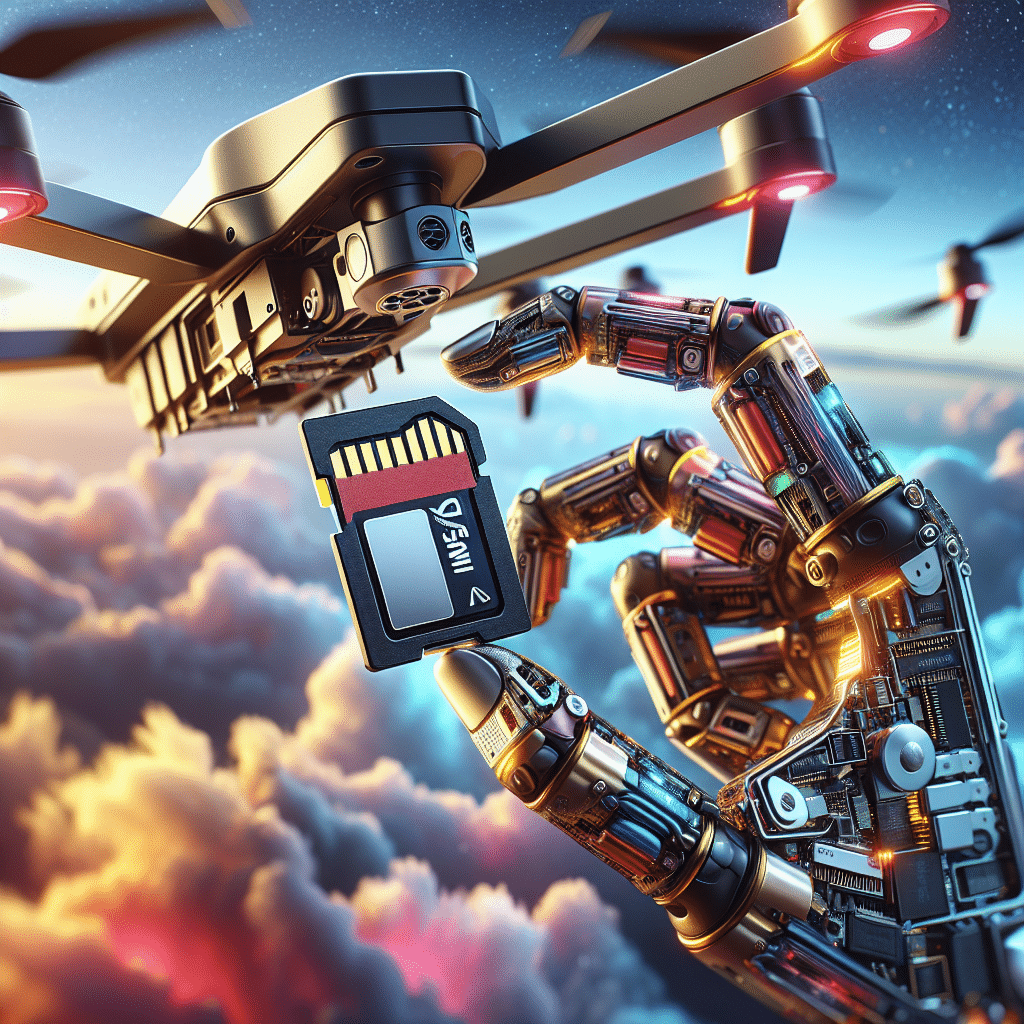Best Memory Card for Drones: Choosing the Perfect Sandisk Size
In This Article
- Select a V30-rated SD card or higher for smooth 4K drone video playback.
- Use SanDisk Extreme Pro for maximum speed and professional reliability.
- Check your drone’s SD card compatibility limits before purchasing.
- Opt for 128GB or 256GB if shooting long 4K sessions regularly.
- Always buy from verified sources to avoid counterfeit issues.
- Back up your footage promptly and always reformat cards in your drone.
Why Your Drone SD Card Choice Matters
Impact of Card Speed and Size on 4K Video
When recording high-definition footage via drones, choosing the right drone SD card becomes absolutely essential. While it may appear to be a minor detail, the memory card you select directly influences the reliability, speed, and quality of your video capture—especially with 4K and high frame rate content. A laggy card can result in dropped frames or even outright failure to record. As drones increasingly become vessels for professional imaging, an appropriate SD card must keep up with the data throughput demands. Do not underestimate the part your SD card plays in the final look of your footage.

Understanding SD Card Speed Classes: What to Look For
UHS Speed, Video Ratings and Write Performance
Speed classes on a drone SD card can be confusing but are critical to understand. Universal Host Speed (UHS) ratings, indicated as U1 or U3, define the minimum sustained write speed. U3 supports at least 30MB/s, sufficient for 4K video capture. Coupled with Video Speed Class indicators such as V30, V60, or V90, these ratings inform you about how well the card handles ultra-high resolution video without buffering or frame skipping. When shopping for cards, always seek out the V30 minimum for 4K, with V60 or higher becoming essential for RAW formats or frame rates above 60fps.
“Choosing a V30 or higher SD card ensures smooth, uninterrupted drone footage—even in extreme conditions.”
Best Sandisk Cards for Drone Use
SanDisk consistently ranks as a top recommendation for drone operators. Specifically, the SanDisk Extreme and SanDisk Extreme Pro series are well-suited for aerial videography. These cards offer UHS-I interface with Video Speed Class V30 or above and are designed to perform in extreme temperatures, shock, X-ray, and water. This resilience matters significantly for drones operating in variable climates and altitudes. The SanDisk Extreme is ideal for intermediate users, while the Extreme Pro offers write speeds of up to 90MB/s—perfect for professionals capturing high-bitrate 4K or RAW formats. These high-performance SanDisk models have been tested extensively in the drone community, earning trust for their reliability and endurance.
Comparing Sandisk Extreme vs Extreme Pro for Drones
The SanDisk Extreme and Extreme Pro might seem similar, but their performance differs meaningfully under drone-specific pressure. While both feature UHS-I and V30 classification, the Extreme Pro tends to handle sustained high-speed writing better, thanks to faster write speeds and lower buffer risk. If you often shoot in burst mode or film in 4K60fps or higher, the Pro model avoids skipping and lag. However, if you’re shooting at lower bitrates or simply capturing scenic stills, the standard Extreme can suffice. Price is also a factor—Extreme Pro cards are often 20% more expensive, so weigh the investment against your drone usage and professional demands.
What’s the Best Size SD Card for Drone Footage?
Storage size ultimately defines how much footage your drone SD card can hold at a time. The right fit depends on how long and frequently you fly. For casual hobbyists shooting short clips or still photos, a 64GB card may suffice. However, professionals often record 4K/60 footage for extended periods, using formats that are immensely data-heavy. In these cases, 128GB or even 256GB are better suited to avoid frequent card swaps mid-flight. Be aware, however, that not all drones can support cards above 128GB, so always check your drone’s specs. Larger cards also benefit from better Green Index Scores (measuring efficiency versus power use).
Top 5 Memory Card Mistakes Drone Users Make
1. Buying Low-Quality or Counterfeit Cards
Many users unknowingly purchase inauthentic SD cards from third-party sellers. These counterfeits may show the right specs but perform well below standard. Always buy from authorised retailers. Official DJI storage card compatibility guide
2. Ignoring Speed Ratings
xChoosing a Class 10 or generic card without V30/U3 verification leads to dropped frames in 4K recording. This mistake is common among new drone pilots.
3. Not Formatting the Card in the Drone
Formatting ensures the file system matches the drone’s requirements. Skipping this step may result in write errors or corrupted data.
4. Using the Same Card for Too Long
Memory cards have life cycles. Overuse leads to failure. Regular replacement ensures performance under critical conditions.
5. Failing to Back Up Content Promptly
Drone crashes happen. Losing footage due to delayed backups is a painful lesson many learn the hard way.
4K Drone Footage: How Much Space You Really Need
On average, 4K footage at 30 frames per second using H.264 encoding consumes approximately 1GB per minute. That means a 64GB card holds a little over an hour of video, excluding system usage and buffers. Moving to 60fps increases consumption to nearly 1.5GB per minute. For RAW formats, data size jumps significantly, often eating up 4GB or more per minute. Thus, professionals filming over extended periods in high-quality settings should look to 128GB or 256GB cards. This ensures uninterrupted flight sessions without sacrificing quality or requiring constant card swaps mid-air. For a complete guide, check Learn more about Essential drone accessories and storage solutions.
Compatibility and Card Fit: Check Your Drone’s Limits
Before purchasing any drone SD card, verify its compatibility with your drone’s hardware. While modern drones like the DJI Mini 3 support 256GB UHS-I cards, older models might cap at 64GB or lack V30 support. Refer to your user manual or the manufacturer’s website to avoid mismatches. Also ensure your drone supports SDXC if you’re opting for cards above 64GB, as SDHC devices may not read them properly. Formatting issues may occur if you swap cards between devices without reformatting. Always perform a deep format within the drone to prevent write and read errors. Read a related article
Drone Storage Tips: Managing and Backing Up Footage
Proper Handling and Storage Protocols
Handle SD cards with care. Use storage cases to prevent physical damage during transport. Avoid exposure to magnets and high temperatures.
Offloading Footage Strategically
Use fast card readers supporting UHS-I to avoid bottlenecks when transferring large 4K files. Always offload content after each flight session to minimise data loss risk.
Backups and Redundancy
Always back up content in two locations: an external drive and cloud service. Redundancy is vital, particularly when filming commissioned shoots or documentary content.
Reformat Cards Regularly
Frequent reformatting clears card errors and optimises longevity. Ensure you do this from within the drone for compatibility.
UK Drone Pilots: Where to Buy Genuine Sandisk Cards
In the UK, reputable online shops like Wex Photo Video, Park Cameras, and Amazon.co.uk (sold by SanDisk) are trustworthy sources for original SD cards. Avoid auction-based platforms or unknown e-commerce stores selling at suspiciously low prices. Always scrutinise the packaging details, holograms, and serial numbers. Counterfeit cards often misreport their capacities and usually die after limited usage. To ensure authenticity, consider purchasing directly from Automated weekly SEO insights from Eldris, the official SanDisk UK distributor.
Choosing Between 64GB, 128GB, and 256GB Cards
The ideal capacity for your drone SD card boils down to usage patterns. A 64GB card suits casual flyers or hobbyists who primarily capture photos and short clips. If you take the drone on longer flights or shoot 4K content frequently, 128GB prevents interruptions. For commercial pilots, wedding videographers, or advanced filmmakers, 256GB enables extended operations without compromise. Larger capacity cards also reduce wear-and-tear as they offer more buffer space and reduce repeated overwriting. Importantly, check if your drone and card reader both support SDXC formatting—this is a must for 128GB and up.
Expert Tips for Buying SD Cards Online Safely
When buying a drone SD card online, stick to authorised retailers and always read verified buyer reviews. Check the seller’s reputation, payment protection policies, and return guarantees. Beware of listings with blurry product photos or vague specifications. Also, always inspect delivery packaging—counterfeit cards often arrive in plain plastic sleeves or tampered boxes. It’s worth registering your SD card on the SanDisk website if this feature is available, as that validates authenticity and warranty coverage. Read warranty terms thoroughly to identify any usage exclusions, especially for professional use cases. For detailed security checklists, consult [INSERT_INTERNAL_LINK_1].
[CONCLUSION_CONTENT]
Great guide on best-memory-card-drones-sandisk-size-guide – Community Feedback
Which Sandisk memory card is best for drones?
The Sandisk Extreme or Extreme Pro microSD cards are highly recommended for drones, offering reliable performance, fast write speeds, and support for 4K video recording. Choose a UHS-I, V30 (or above), with 64GB–256GB as the ideal balance for most pilots.
Is 128GB enough for drone footage?
A 128GB Sandisk card suits most drone flyers, providing ample space for multiple 4K flights. Only professional or extended sessions may need 256GB or more. For casual use, 64GB-128GB is safe and reliable.
How do I choose the right SD card size for my drone?
Match your drone’s recording quality: 4K video requires at least a V30, U3, UHS-I microSD card. For flight logs and RAW footage, 64GB to 128GB balances storage and speed – check your drone model’s maximum supported size before purchase.

